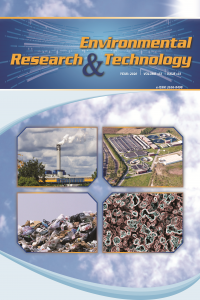Research Article
Year 2020,
Volume: 3 Issue: 3, 94 - 101, 30.09.2020
Abstract
References
- [14] C.J. Carter, R.A. Blizard, “Autism genes are selectively targeted by environmental pollutants including pesticides, heavy metals, bisphenol A, phthalates and many others in food, cosmetics or household products”, Neurochemistry International 101, 83-109, 2016. [15] D.N. Roy, R. Goswami, A. Pal, “The insect repellents: A silent environmental chemical toxicant to the health”, Environmental Toxicology and Pharmacology 50, 91–102, 2017. [16] J.M. Brausch, G.M. Rand, “A review of personal care products in the aquatic environment: Environmental concentrations and toxicity”, Chemosphere 82, 1518–1532, 2011.
Year 2020,
Volume: 3 Issue: 3, 94 - 101, 30.09.2020
Abstract
With the increasing concern of emerging contaminants (ECs), advanced oxidation processes (AOPs) have been widely investigated to fulfill the drinking water quality because of the potential adverse health effects of ECs. Accordingly, N,N-diethyl-meta-toluamide (DEET) is selected as a model compound belonging ECs to monitor its ultrasonic oxidation which is one of the most popular AOPs in a dual frequency ultrasonic reactor (DFUR) using low-frequency probe (20 KHz) and high-frequency transducer (640 KHz) type sources. DFUR was calorimetrically optimized in terms of power densities of both ultrasonic sources in order to provide the highest sonochemical yield with efficient energy output. Pseudo-first order kinetic equation was applied to results by measuring the concentration decreasing during the oxidation reactions. The pseudo-first-order rate constants, k, increased from 7.8x10-3 min-1 (640 kHz, R2=0.930) to 13.5x10-3 min-1 (DFUR, R2=0.990), by contrast, the rate constant was only 0.7x10-3 min-1 (R2=0.281) for 20 kHz low-frequency ultrasonic source. DEET oxidation was evaluated with the presence of different gas saturation (Ar, Air, O2, and N2); addition of hydrogen peroxide (PO), persulfate (PS) and monoperoxysulfate (MPS) and PO concentration effect (molar ratio of DEET:PO; 1:1, 1:2, 1:5, 1:10 and 1:20). The DEET oxidation rate was calculated as 35.8 x10-3 min-1 (R2=0.994) in the presence of Argon gas saturation, while it was 13.5 x10-3 min-1 (R2=0.990) when no gas bubbling. Therefore, the main degradation pathway was predicted as pyrolysis taking place inside the cavitation bubble where DEET molecules can reach. On the other side, a lower degradation rate in the presence of PO, PS, and MPS than that of no additives has indicated that the bulk phase degradation pathway for some part of DEET molecules are still occurred.
References
- [14] C.J. Carter, R.A. Blizard, “Autism genes are selectively targeted by environmental pollutants including pesticides, heavy metals, bisphenol A, phthalates and many others in food, cosmetics or household products”, Neurochemistry International 101, 83-109, 2016. [15] D.N. Roy, R. Goswami, A. Pal, “The insect repellents: A silent environmental chemical toxicant to the health”, Environmental Toxicology and Pharmacology 50, 91–102, 2017. [16] J.M. Brausch, G.M. Rand, “A review of personal care products in the aquatic environment: Environmental concentrations and toxicity”, Chemosphere 82, 1518–1532, 2011.
There are 1 citations in total.
Details
| Primary Language | English |
|---|---|
| Subjects | Environmental Engineering |
| Journal Section | Research Article |
| Authors | |
| Publication Date | September 30, 2020 |
| Submission Date | June 8, 2020 |
| Acceptance Date | July 9, 2020 |
| Published in Issue | Year 2020 Volume: 3 Issue: 3 |

